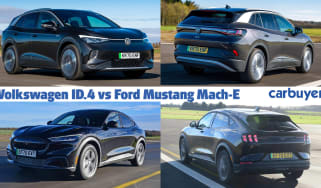Volkswagen ID.4 review – a good-to-drive, but imperfect electric SUV
"The Volkswagen ID.4 is a fun and practical zero-emissions SUV"
Pros
- Good to drive
- Competitive range
- Great practicality
Cons
- Frustrating infotainment
- Expensive top versions
- Some cheap materials
Verdict – is the Volkswagen ID.4 a good car?
As one of the first mass-market electric SUVs to hit the market, the Volkswagen ID.4 made sense for a large proportion of buyers when it launched. It's easy to live with, practical and offers a decent range with the option of rapid charging on longer trips. The problem is, recent years have seen the arrival of fiercer, more affordable and better-built EV SUV rivals, so the obvious answer is no longer necessarily ID.4.
Volkswagen ID.4 models, specs and alternatives
The Volkswagen ID.4 was the brand’s first electric SUV, joining the lineup after the ID.3 hatchback. Its high-riding SUV styling is very en vogue at the moment, but it shares many of its underpinnings with the smaller hatchback. Lots of rival manufacturers have since gotten in on the act, so it faces lots of competition, such as the Kia Niro EV, Hyundai Kona Electric, Skoda Enyaq, Renault Scenic and upmarket models like the Audi Q4 e-tron, Tesla Model Y or Volvo EX40.
The Volkswagen ID.4 starts from just under £40,000, which now looks pricey against some of the aforementioned competition. The closely-related Skoda Enyaq, for example, starts from just over £36,000, and there’s less of a gap between Skoda and Volkswagen in terms of quality these days. The market is rapidly evolving, so newer arrivals such as the Renault Scenic are cheaper, too, while arguably bringing a little more design flair to the table.
 Top 10 best electric SUVs – the ones to buy in 2024
Top 10 best electric SUVs – the ones to buy in 2024
Sitting between the Volkswagen Tiguan and seven-seat Volkswagen Tiguan Allspace in size, the ID.4 shares its design theme with the ID.3. It gets a much bolder and more modern look when compared to the conservative Tiguan, with smooth lines, large alloy wheels and coast-to-coast front and rear lights. The ID.4 also boasts trendy SUV-style plastic wheel arches and side skirts for a tougher look, while a silver graphic above the side windows helps it stand out from the masses.
The interior has a simple design, dominated by a new infotainment setup with a large central touchscreen above the dashboard with a smaller driver's display behind the steering wheel. It should be as easy to use as a smartphone, so it's a shame the system isn't particularly intuitive, with too many steps required to operate rudimentary functions. Hopefully this can be improved with wireless updates in future. It mostly feels sturdy inside but the presence of some cheaper plastics hints at cost cutting in places.
The Volkswagen ID.4 is offered with either a 52kWh battery in entry-level Pure spec, or a 77kWh in every other model above this. The 52kWh battery is good for a range of up to 222 miles, while the 77kWh version has the best range of up to 349 miles, so long as you stick to the two wheel-drive version with the Pro powertrain. Go for Pro 4Motion four wheel-drive, and the range drops to 326 miles, and go for the hot performance-focused GTX 4Motion and it drops further to 319 miles.
The ID.4 is good and easy to drive, and there are a few different power outputs to choose from. Pure models have 168bhp from a single motor which sends power to the rear wheels and is capable of 0-62mph in nine seconds, which isn’t quite as brisk as many have grown to expect from an EV. The Pro model is still rear-wheel drive, but gets a significant power bump with 282bhp, which enables it to do the same sprint in 6.7 seconds. If you want the extra stability of four wheel-drive, this version cuts the sprint time by just a tenth of a second. The GTX is the flagship of the range, and is geared towards performance – it has 335bhp and accelerates from 0-62mph in just 5.4 seconds.
While it was previously offered in more trims, the Volkswagen ID.4 lineup now leaves you merely to choose the powertrain as all but the GTX are offered in Match trim. This includes 19-inch alloy wheels, LED headlights, heated front seats, keyless entry and go, a rear-view camera, though the Match models with the Pro powertrain and above also get an electrically operated tailgate.
The GTX is more of a standalone model, getting its own 20-inch alloys, a slightly racier look, 360-degree parking camera, panoramic glass roof, and a suite of extra driver convenience features.
Which Is Best?
Cheapest
- Name125kW Match Pure 52kWh 5dr Auto [19'' Alloys]
- Gearbox typeAuto
- RRP£39,580
Most Economical
- Name210kW Match Pro 77kWh 5dr Auto
- Gearbox typeAuto
- RRP£44,390
Fastest
- Name250kW 4MOTION GTX Edition 77kWh 5dr Auto
- Gearbox typeAuto
- RRP£52,825


























